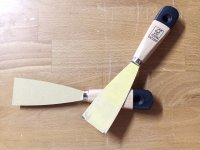Birdhunter
Member
- Joined
- Jun 16, 2012
- Messages
- 4,108
I’m an old dog but I just learned a new trick. I needed to remove some wayward glue from the inside of a box lid I made for a charity. I just couldn’t find the right tool.
I ended up trimming the round end of a tongue depressor off square. I had some rolls of adhesive backed sandpaper. I fitted some 80 grit on one side of the tongue depressor and 180 grit on the other. I then had a very flexible sanding tool that allowed me to get into the corners hiding the dried glue.
The tongue depressor can be trimmed to fit any corner and carry any grit paper. Neat!
I ended up trimming the round end of a tongue depressor off square. I had some rolls of adhesive backed sandpaper. I fitted some 80 grit on one side of the tongue depressor and 180 grit on the other. I then had a very flexible sanding tool that allowed me to get into the corners hiding the dried glue.
The tongue depressor can be trimmed to fit any corner and carry any grit paper. Neat!



